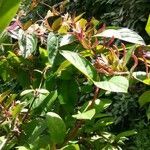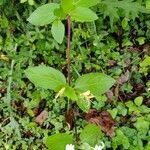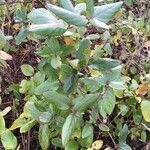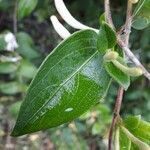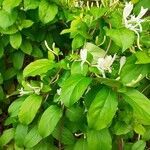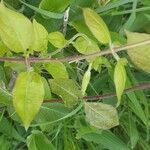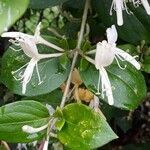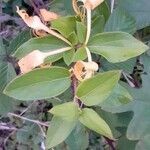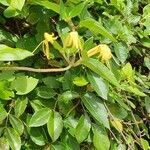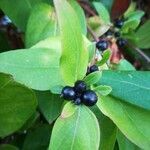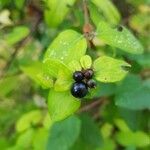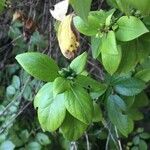Climbers, semievergreen. Branches becoming hollow. Branches, petioles, and peduncles with dense, yellow-brown spreading stiff hairs, interspersed with long glandular hairs. Petiole 3-8 mm; leaf blade ovate or oblong to lanceolate, 3-8 × 1.5-4 cm, abaxially sparsely to densely hairy, adaxially hairy along veins, base rounded to subcordate, margin ciliate, occasionally sinuate, apex acute to acuminate. Flowers fragrant, paired and axillary toward apices of branchlets; peduncle 2-40 mm, shorter toward apex of branchlets; bracts leaflike, ovate to elliptic, 1-3 cm; bracteoles ca. 1 mm, pubescent, apex rounded or truncate and ciliate. Neighboring 2 ovaries free; ovary ca. 2 mm, glabrous. Calyx lobes triangular, ca. 1 mm, densely hairy abaxially and along margin, apex acute. Corolla bilabiate, white, becoming yellow, or purple outside and white inside, 3-5 cm, spreading hairy with interspersed long glandular hairs outside; tube 1.5-3 cm, not gibbous at base; upper lip irregularly 4-lobed, lobes 2-8 mm; lower lip recurved. Stamens and style glabrous, subequaling to exceeding corolla. Berries black when mature, glossy, globose, 6-7 mm in diam.; seeds brown, ovoid or ellipsoid, ca. 3 mm, shallowly pitted. Fl. Apr-Jun, fr. Oct-Nov. 2n = 18*.
Vigorous climber, evergreen, or semi-evergreen in cold districts. Stems mostly purplish and hirsute when young. Lvs dimorphic: those produced in colder weather in early spring sinuate to deeply lobed; summer lvs and those on reproductive shoots entire. Petiole to 1.3 cm long, densely hirsute. Lamina of entire lvs 2.5-12 × 1.5-6 cm, ovate-oblong, ovate or ovate-elliptic, usually deep ± shining green or sometimes yellowish green above, lighter green below, sometimes mottled yellow, densely hairy to glabrous on veins beneath; midrib above glabrous or hairy; base rounded, truncate or subcordate; apex obtuse to acute; lvs subtending fls similar but smaller, all free. Fls in axillary pairs, fragrant; peduncles 0.5-2.5 cm long, densely hirsute. Bracteoles ± oblong-obovate, much < ovaries. Calyx lobes very small, ± narrow-triangular, fringed with long hairs. Corolla 2-4.5-(5) cm long, usually white, becoming yellow after anthesis, often flushed pink on reverse, glandular-hairy outside; tube 1-3 cm long, cylindric; limb 2-lipped; single linear lobe of lower lip recurving; upper lip 4-toothed. Stamens and style < to = corolla limb. Ovaries separate. Berry (4)-5-7 mm diam., broad-ovate to suborbicular, glossy black. Seed c. 2 mm diam.
Twining. Twigs short-pubescent, glabrescent, sparsely glandular-hairy, shiny-brown, ultimate internodes short-tomentose. Leaves ovate-oblong to ovate-lanceolate, base rounded to truncate, apex acute, acutish or subacuminate, midrib and edges pilose, darkgreen and shiny above; 3-8½ by 1½-4 cm, petiole ¾-1 cm. Flowers fragrant, 3-5 cm. Peduncle ¼-1½ cm, tomentose. Bracts pet-ioled, leafy, oblong-ovate, or oblong-obovate, 10-18 by 4-8 mm. Bracteoles roundish, ¾ mm, hairy, glandular, ciliate. Calyx-lobes linear from a triangular base, haired, ± 1½ mm, ciliate. Corolla 4-5 cm, creamy, or pale rosa-tinged towards the base, fading orange-yellow, lobes as long as the tube, hairs mixed with capitate glandular hairs, tube ± 2½ cm, lobes ⅓ of the limb of upper lip. Style glabrous, ± as long as the corolla. Stamens glabrous. Berry globular, 6-7 mm diam., black.
Twining vine or shrub to 10 m long or more, trailing at ground level or festoon-ing on shrubs or small trees; stems terete, sometimes reddish on one side, loosely to densely pubescent with slender and stout simple hairs to 1 mm long, some hairs gland-tipped, the glands mostly transparent but drying reddish-brown, the hairs on the young parts retrorse. Leaves opposite, not connate, entire (lobed on juvenile plants), ovate, oblong, or elliptical, mostly widest at the middle or below, apically acuminate, acute or obtuse, often mucronulate, basally rounded, truncate
An evergreen climber which grows 7.5-9 m long. It can be 15 m long. The young stems are hairy. The leaves are hairy underneath. The leaves are dark green on the upper surface and light green below. The leaves sometimes have lobes. They are 2.5-10 cm long by 1.5-4.5 cm wide. The flowers are white tubes with a sweet smell. They occur in pairs in the axils of leaves. The flower stalk is 1-2.5 cm long. The flower tube is 2-3 cm long. The fruit are blue-black berries. They are 5-7 mm across.
Trailing or climbing vine, the young stems hairy; lvs ovate to oblong, 4–8 cm, rounded or broadly cuneate at base, sometimes toothed or lobed, glabrescent or hairy; peduncles axillary, 5–10 mm; bracts ovate, foliaceous; bractlets rotund, ciliate; cor 3–5 cm, strongly bilabiate, white or cream, the tube about equaling the lips; fr black; 2n=18. Native of e. Asia, now well established in woods and fields in our range. (Nintooa j.)
